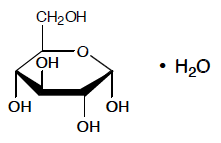Influence of the Pan on Dehydration, Glucose Monohydrate
Sample
α-D-Glucose monohydrate
Application
Inactive ingredient, filler for tablets and capsules
Conditions
Measuring cells: DSC820 or TGA850
Pan DSC: Aluminum 40 µl, hermetically sealed or with pierced lid
Pan TGA: Aluminum 100 µl, with pierced lid
Sample preparation: As received, no preparation
DSC measurement: Heating from 30 °C to 250 °C at 20 K/min
TGA measurement: Heating from 30 °C to 300 °C at 20 K/min
Atmosphere: Nitrogen; DSC: 50 cm3/min, TGA: 80 cm3/min
Interpretation
A comparison of the two DSC curves of α-D-Glucose monohydrate shows the changes that arise when the sample is measured in a sealed pan or in a pan with a pierced lid. In a hermetically sealed pan the sharp melting peak of the monohydrate can be observed. If a pan with a pierced lid is used, the water of crystallization can escape. This is noticeable as a shift of the DSC curve at the beginning of the measurement and as a broad evaporation peak. At the same time, a transition to β-D-Glucose anhydrate occurs, the melting point of which is at about 158 °C. Above 200 °C the glucose starts to caramelize.
Evaluation DSC
| Measuring condition | Onset, °C | Effect |
|---|---|---|
| Sealed pan | 81.4 | melting |
| Pan with pierced lid | 157.4 | melting |
Interpretation
Thermogravimetric measurements using a pan with a pierced lid confirm the interpretation of the results obtained from the DSC curves, in particular the weight loss caused by the evaporation of the water of crystallization as well as the melting of the β-D-Glucose anhydrate afterwards. The weight loss step of 7% between 53 °C and 134 °C is somewhat less than that expected stoichiometrically. It can be explained however by a loss of water of crystallization during storage of the sample.
Evaluation TGA
| Temperature, °C | Effect | |
|---|---|---|
| TGA, step | 53-134 | 7.0% weight loss (water of crystallization) |
| SDTA, onset | 59 | endothermic peaks |
| SDTA, onset | 154.2 | melting peak |
Conclusion
A substance that contains water of crystallization and its anhydrous form normally have different melting points (pseudopolymorphism). The melting point of the form containing the water of crystallization can be determined in a hermetically sealed pan, provided that no decomposition occurs. In an open pan the water of crystallization can escape so that the melting point of the anhydrous form is measured. The presence of a form with water of crystallization should always be confirmed by measuring the weight loss.
Influence of the Pan on Dehydration, Glucose Monohydrate | Thermal Analysis Application No. HB815 | Application published in METTLER TOLEDO TA Application Handbook Pharmaceuticals